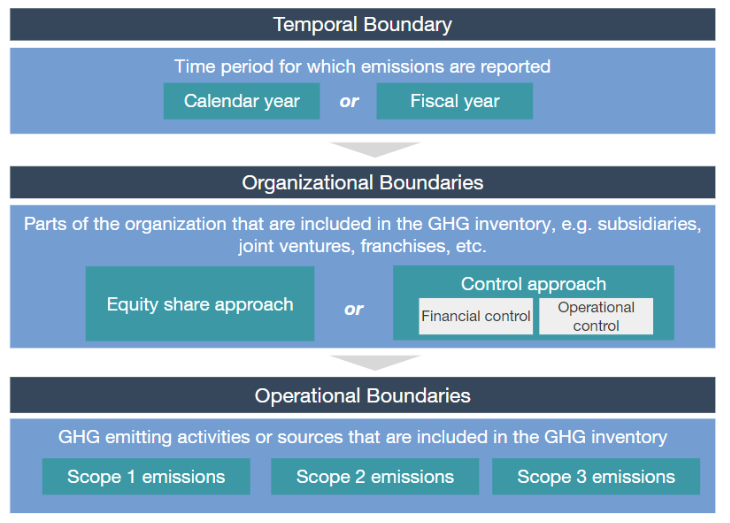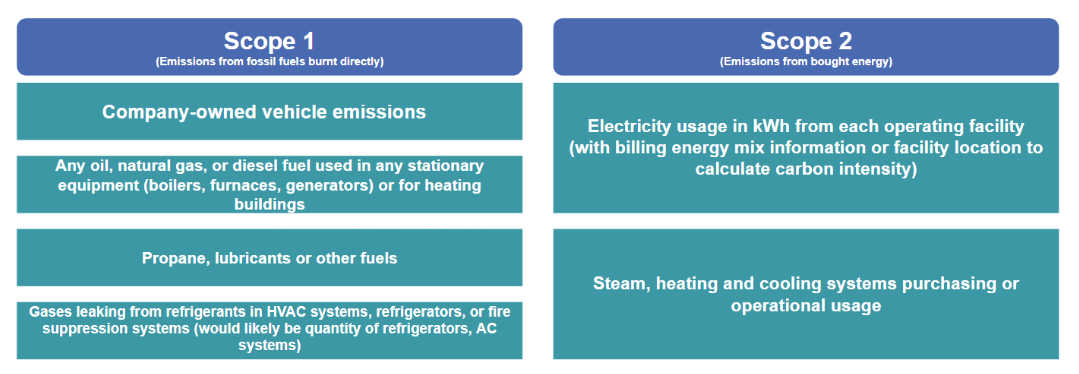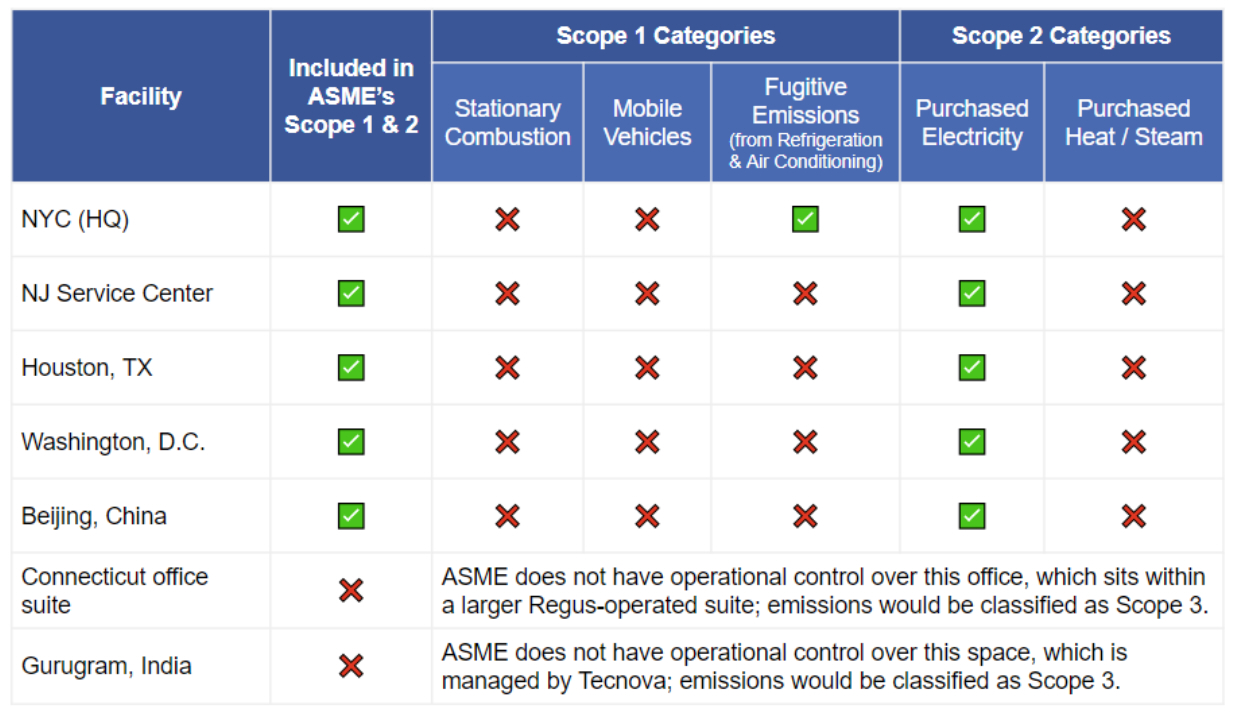ASME’s Greenhouse Gas Accounting Methodology
Emissions Scopes 1 & 2
About GHG Accounting
The climate-warming greenhouse gas (GHG) emissions of an organization are classified into one of three categories, called scopes. Total GHG emissions are the sum of emissions of various gases: carbon dioxide (CO2), methane (CH4), nitrous oxide (N2O), and smaller trace gases such as hydrofluorocarbons (HFCs) and sulfur hexafluoride (SF6).
When companies and other organizations make plans to control their climate pollution, many start by sorting their activities into these different scopes. The three scopes and what they cover are as follows (credit: MIT Climate Portal):
Scope 1 emissions are GHGs a company puts into the atmosphere with its own properties and operations. For instance, when a company combusts fuel oil or natural gas to heat its buildings, the emissions created are CO2, CH4, and N2O. Those emissions belong in scope 1.
Scope 2 emissions are indirect GHG emissions associated with the purchase of electricity, steam, heat, or cooling.. These are “indirect” emissions that are generated at distant power plants. Still, as with scope 1 emissions, the company is clearly and solely responsible for them. If it used less electricity, there would be less demand for coal, gas and other fossil fuel energy sources.
Scope 3 emissions include all other indirect sources of GHGs from the company’s operations and products sold. These might relate to the day-to-day running of the company: for instance, if a company prints a magazine for its membership, the GHG emissions from the manufacture of the paper used would fall under scope 3. They might be upstream in the organization’s supply chain, like when a car company buys steel: manufacturing that steel creates some GHGs. Or the emissions might be downstream, like when a car company sells a car, which someone then fills with gas, creating more scope 3 emissions.
Methodology
Initiation:
In July 2023, ASME initiated planning for an inaugural GHG emissions measurement exercise. With endorsement of Executive leadership, the ASME Sustainability Steering Committee (SSC)—a staff-secretariat—proceeded with a phased approach, starting with Scope 1 and 2 calculations. This initial phase ran from August through November 2023. Given time and resource constraints, ASME agreed to phase-in Scope 3 calculations at a later date. All major steps in Scope 1 and 2 data gathering and calculations were done with the support from climate advisory firm OnePointFive (OPF).
Process:
ASME aligned its approach to the GHG Protocol Corporate Accounting and Reporting Standard, which provides requirements and guidance for companies and other organizations preparing a GHG emissions inventory.
Leveraging the GHG Protocol Corporate Accounting and Reporting Standard enables ASME to:
- Prepare a GHG inventory that represents a true account of emissions through the use of standardized approaches and principles.
- Provide the enterprise with information that can be used to build an effective strategy to measure, report, manage and reduce GHG emissions
Boundary-Setting and Data Collection:
ASME established the temporal, organizational and operational boundaries to help guide the GHG emissions inventory data collection, calculation and analysis processes. The process is illustrated in the graphic below.
As with other major reporting activities, ASME will use its fiscal year as the temporal boundary, with July 2022 - June 2023 being the baseline year.
The operational control approach was used to set organizational boundaries. As a result, the following ASME facilities were included within the Scope 1 and 2 inventory:
- New York City - ASME HQ
- New Jersey - Service Center
- Houston, TX
- Washington, D.C.
- Beijing, China
ASME’s two offices in Connecticut and India were determined to not be operationally controlled by ASME. Consequently, emissions from these would be categorized as Scope 3 and calculated at a later stage.
The GHG Protocol includes the following as potential emissions sources within Scope 1 and Scope 2 categories:
ASME set operational boundaries (i.e., determined the emissions sources to include in ASME’s Scope 1 & 2 GHG inventory), based on an assessment of the following, material categories using a detailed questionnaire:
- Facility Information
- Stationary Combustion
- Mobile Vehicles
- Refrigeration and Air Conditioning
- Fire Suppression
- Purchased Gasses
- Purchased Electricity
- Purchased Heat / Steam
- Across all in-scope office spaces, the landlord / building management controls and pays for heat generation, so Stationary Combustion and Purchased Heat / Steam are excluded from the inventory.
- ASME does not own or lease any vehicles.
- In the NYC office, air conditioner units were serviced and refrigerant fluid replaced in FY23, which generated fugitive emissions. Fugitive emissions are defined as climate-warming gasses that escape from containment, either as a leak or due to human intervention. Many common refrigerants possess a global warming potential hundreds and thousands of times greater than carbon dioxide.
- Where ASME does own or manage fire extinguishers on-site, the units are provided pre-filled by the supplier, so they did not generate fugitive emissions in FY23.
Calculation:
The U.S. Environmental Protection Agency (EPA) Calculation Tool was used to calculate Scope 1 and 2 emissions. The SSC reviewed the analysis and recommended publication of findings and prioritization of Scope 3 emissions calculation, given the likely materiality and breadth of the emissions sources, to complete the baselining and establish a Net Zero strategy.
Next Steps:
As part of ASME’S long-term climate strategy, a robust analysis of emissions across suppliers, operational facilities, and events, significant data collection and analysis will be required . For these Scope 3 calculations, a carbon accounting software platform will be sourced and selected to help drive:- Consistency in results
- Familiarity with the tool
- Speed of calculation
- Visualization
All collected data will be verified, cleansed and deemed complete and accurate before being imported into the carbon accounting software for Scope 1, 2 and 3 emissions.
Given Scope 1 and 2 was completed for the baseline year of FY23, Scope 3 data collection, will also focus on FY23, and the recommendations from the emissions hotspot analysis will be considered in the context of the earlier measured Scope 1 and 2 emissions.
Once this is complete, ASME will shift to the analysis and recommendations, including an implementation plan covering emissions reductions tied to ASME’s baseline accounting to translate the Scope 1, 2 and 3 emissions and emissions hotspots into actionable outcomes.


